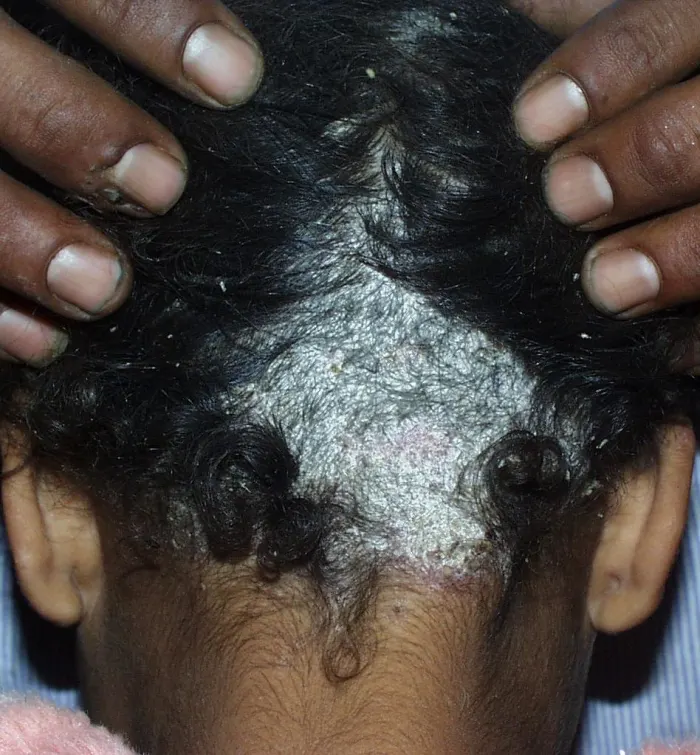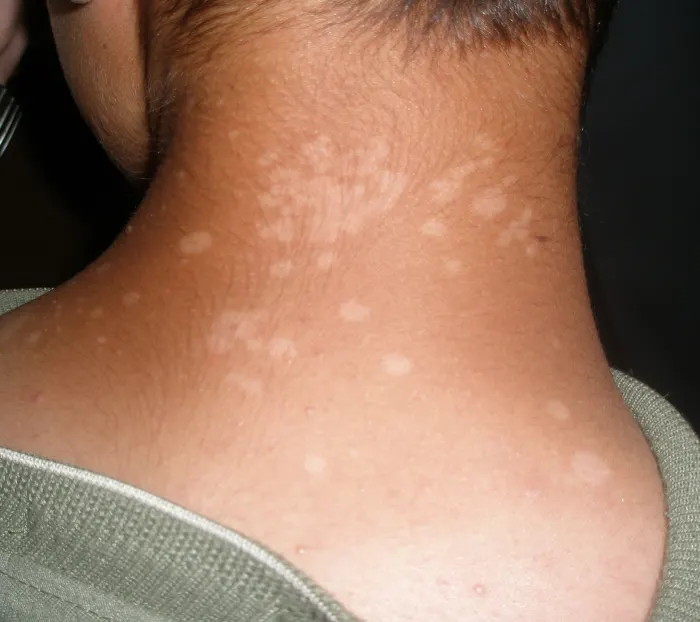
Tinea Capitis
Tinea Capitis And Tinea Vesicolor
Tinea Capitis: Boys are more affected than girls. Several species of microsporon or trichophyton are capable of affecting the scalp. Infection may be transmitted from humans or from animals such as cats and dogs by direct or indirect contact.
The lesions may be scaly, kerion type or black- dot types. Scaly type is the most frequent and it is characterized by a circular patch or patches of partial alopecia. There are grayish scales and lusterless stumps of hair. The inflammatory type of fungal infection is called kerion. It is characterized by a boggy red swelling, which does not discharge pus but shows a serous exudates. The black dot variety is caused by a variety of endothrix fungi in which the mycella of the fungus grow insided the shaft of the hair. The appearance of black dots is caused by the hair. The appearance of black dots is caused by the hairs breaking flush with the surface of the skin.

Tinea Versicolor: It is a relatively trivial, often asymptomatic and non-inflammatory type of fungi infection of the skin, which tends to be chronic. Warm humid climate is conducive to fungal growth. The causative organism is Malassezia furfur (pityrosporon furfur). The lesions are multiple hypopigmented macules with geographical margins.
The colour varies from whitish fawn to brown. Achromia parasitica is the term applied to T. versicolor which is non-pigmented. The term versicolor is applied since the lesions vary in colour. Sites of involvement are the upper trunk, front and back of the chest and less commonly the lower abdomen, neck and face. The fungus can be demonstrated in scales scraped from the lesions.
Treatment
Tinea versicolor responds rapidly to any of the common fungicides, particularly to solutions or creams containing sodium thiosulphate, tolnaphthate or 9-amino acridinium 4-hexyl resorcinolate. Thorough scrubbing with soap and water or cleaning with selenium sulphide improves the condition rapidly but relapse is the rule.
Drugs Used For The Treatment Of Superficial Mycoses
| Drug | Dose | Main Toxicity |
|---|---|---|
| Griseofulvin | 500 to 1000 mg orally for 2 weeks to 1 year | Photosensitivity, urticeria, gastrointestinal disturbance, hepatoxicity |
| Ketoconazole | 200 to 400 mg orally, daily | Rashes, hepatoxicity, gynecomastia |
| Miconazole | Oral gel, 125 mg four times daily, parenteral, 500 to 1000 mg intravenously, 8 hourly, intrathecal 20 mg, topical 2% cream or 100 mg pessary | Mild local reaction, anaphylaxis, nephrotoxicity, hyponatremia, hyperlipidemia and acute psychosis |
| Nystatin | Oral 50,000 U for every 6 hours, topical 10,000 U/g ointment or vaginal tablet for 6 days | Rash, lymphadenopathy, parotitis, lacrimation, dermatitis |
| Clotrimazole | 1% cream or 100 mg vaginal tablet for 6 days | Mild local effects |
| Econazole | 1% cream or powder | Nil |
| Potassium Iodide | Saturated solution (1 g/ml); 10 drops four times daily, orally, increased to 40 drops/ 8 hourly, if tolerated | Rash, lymphadenopathy, parotitis, lacrimation, iodism |
Tinea Versicolor
Skin diseases
Treatment Of Superficial Mycosis

Systemic therapy consists of the used of the antibiotic griseofulvin. It is very effective in superficial mycosis, especially in ringworm of the nails and scalp. When given orally, this drug is incorporated in the skin, hair and nails during their growth, thus making them unacceptable to the fungi which are cast off in the process of normal desquamation. Growing stages of the fungi are more susceptible. The dose is 0.5 g given twice daily orally. For children, the dose is 10 mg/Kg daily. The duration of the treatment depends on the site of lesion. Lesions over the glabrous skin need medication only for three weeks. In the case of infection of the toe nails, the drug has to be given for a period of 6 months, and for finger nails, three months or even longer. Treatment failure are invariably due either to inadequate dose or incomplete course. Adverse side effects of griseofulvin include skin rashes, photosensitivity, mild diarrhea, headache and impairment of judgment. The drug has to be avoided during pregnancy.
In the case of tinea infection of the skin- tinea corporis, tinea cruris, tinea pedis and tinea capitis- topical applications of antifungal drugs are quite effective. The commonly available drugs are given in the table above.
Leave a Reply